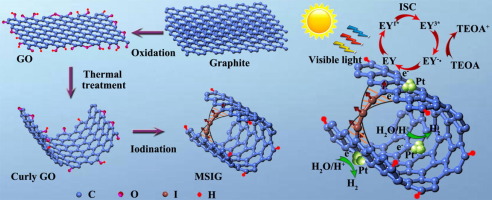Journal of Catalysis ( IF 6.5 ) Pub Date : 2017-09-23 , DOI: 10.1016/j.jcat.2017.08.021 Xuqiang Zhang , Bin Tian , Wenlong Zhen , Zhen Li , Yuqi Wu , Gongxuan Lu

|
Charge transfer between the two surfaces of graphene is limited due to the anisotropy of graphene structure. To overcome this anisotropy of graphene in charge transfer, construction of an equivalent Möbius strip by iodination can provide a feasible approach to altering the charge transfer route by fabricating a coplanar structure. In this work, the conductivity, carrier concentration, mobility, and charge transfer efficiency of a Möbius-strip-like iodination graphene (MSIG) are significantly improved owing to the coplanar character of the topology, which is stitched by chainlike connected polyiodides (I3− and I5−) over the edge of graphene. Such a Möbius-strip-like route offered easier electron tunneling between two graphene surfaces by strong Rashba spin–orbit coupling and flip–flop electron tunneling, and this flip–flop electron tunneling bridged the easier transfer route between far-located carbon atoms at the edges of graphene through the p orbitals in polyiodides. As a result, the electron transfer between the two graphene surfaces was enhanced. Activity results indicated that the photocatalyst MSIG/Pt based on such Möbius strip graphene exhibited better hydrogen evolution activity than un-iodide-doped graphene. The highest quantum efficiency, 35.6%, was achieved at 430 nm when Eosin Y was used as a photosensitizer. This enhancement could be attributed to lower energy consumption during electron transfer in MSIG from excited Eosin Y to the Pt co-catalyst because of reduced recombination of photogenerated carriers and prolonged lifetimes of photogenerated electrons.
中文翻译:

莫比乌斯带状石墨烯的构建,可实现高效电荷转移和高活性氢释放
由于石墨烯结构的各向异性,限制了石墨烯两个表面之间的电荷转移。为了克服石墨烯在电荷转移中的各向异性,通过碘化构造等效的莫比乌斯带可提供一种可行的方法,通过制造共面结构来改变电荷转移路径。在这项工作中,导电性,载流子浓度,迁移率,电荷转移效率莫比乌斯-带状碘化石墨烯(MSIG)被显著改善由于拓扑结构,这是由链状连接聚碘缝合的共面字符(I 3 -我5 -)在石墨烯的边缘。通过强大的Rashba自旋轨道耦合和触发器电子隧穿,这种类似于Möbius条纹的路线使两个石墨烯表面之间的电子隧穿更加容易,并且该触发器电子隧穿桥接了位于远处的碳原子之间较容易的转移路线。通过p的石墨烯边缘多碘化物中的轨道。结果,增强了两个石墨烯表面之间的电子转移。活性结果表明,基于这种莫比乌斯带状石墨烯的光催化剂MSIG / Pt比未掺杂碘的石墨烯具有更好的析氢活性。当曙红Y用作光敏剂时,在430 nm处达到了最高的量子效率35.6%。这种增强可以归因于在MSIG中电子从激发的曙红Y转移到Pt助催化剂过程中的较低的能量消耗,因为光生载流子的复合减少,光生电子的寿命延长。











































 京公网安备 11010802027423号
京公网安备 11010802027423号